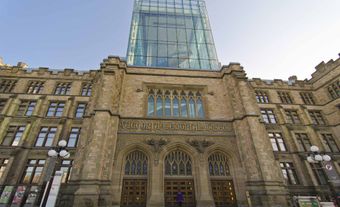Ontario became one of the founding members of the Dominion of Canada on 1 July 1867 when it joined New Brunswick, Nova Scotia and Québec in Confederation.
Province of Canada
Upper Canada (Ontario) and Lower Canada (Québec) merged into the Province of Canada as a result of the rebellions that disrupted the territories in 1837. The merger came largely out of the Durham Report, in which Lord Durham argued that a combined colony would offer an improved system of commerce and ensure the survival of an English-speaking majority.
Durham described them as “two nations warring in the bosom of a single state.” He recommended assimilating the French, a “people with no literature and no history” in his view, under the government of a single legislature.
The union came into effect in 1841. The new province — consisting of the renamed Canada West (Ontario) and Canada East (Québec) — struggled financially at times. New waves of British immigration could not find farmland beyond the Canadian Shield, which stunted the growth of the colony.
In February and March 1849, the Montréal Riots erupted, when protests against the weakened economic state of the colony, and the passing of the Rebellion Losses Bill, drew angry crowds into the streets. They threw rotten eggs and stones at the carriage of Governor General Lord Elgin. That night, people burned the Parliament building in Montréal.
The capital of the province subsequently moved out of Montréal. Confederation was proposed as a way of easing these French-English tensions, and of resolving the state of political deadlock that had arisen between Canada East and Canada West, making the combined colony difficult to govern.
Confederation Talks
A new way forward emerged in 1864, when three of the province’s four political parties backed Confederation. In Upper Canada (Ontario) John A. Macdonald led the Conservatives, while George Brown rallied the Clear Grits. In Lower Canada (Québec) A.A. Dorion’s Parti Rouge opposed it, while George-Étienne Cartier’s Conservatives supported it. Proponents said French Canada would get its provincial capital and its identity back, and Québec's interests would be protected in Confederation by a French presence in a federal Cabinet.
Given that their neighbours to the south were about to fall into the brutal American Civil War, cooler heads also sought a more peaceful way to live together in Canada. Some feared an expansionist United States might annex parts of British North America, and saw that Confederation would provide strength to resist any such aggression.
Macdonald, Cartier and other members of a Canadian delegation attended the Charlottetown Conference in 1864. Originally designed to discuss Maritime Union, the Charlottetown meeting resulted in an agreement between the Canadians and the Maritime colonies to pursue Confederation. This was followed by another meeting in Québec City, in which the details of Confederation were ironed out.
The Province of Canada broke up in early 1867, being divided into Ontario and Québec; the Dominion of Canada brought them together, plus New Brunswick and Nova Scotia, as provinces in Confederation on 1 July 1867.
Fathers of Confederation
The “Fathers of Confederation” are the men who attended one or more of the conferences at Charlottetown, Québec City, and finally London. For Ontario, that includes George Brown, Sir Alexander Campbell, James Cockburn, William Pearce Howland, Sir John A. Macdonald and Sir Oliver Mowat.

 Share on Facebook
Share on Facebook Share on X
Share on X Share by Email
Share by Email Share on Google Classroom
Share on Google Classroom






